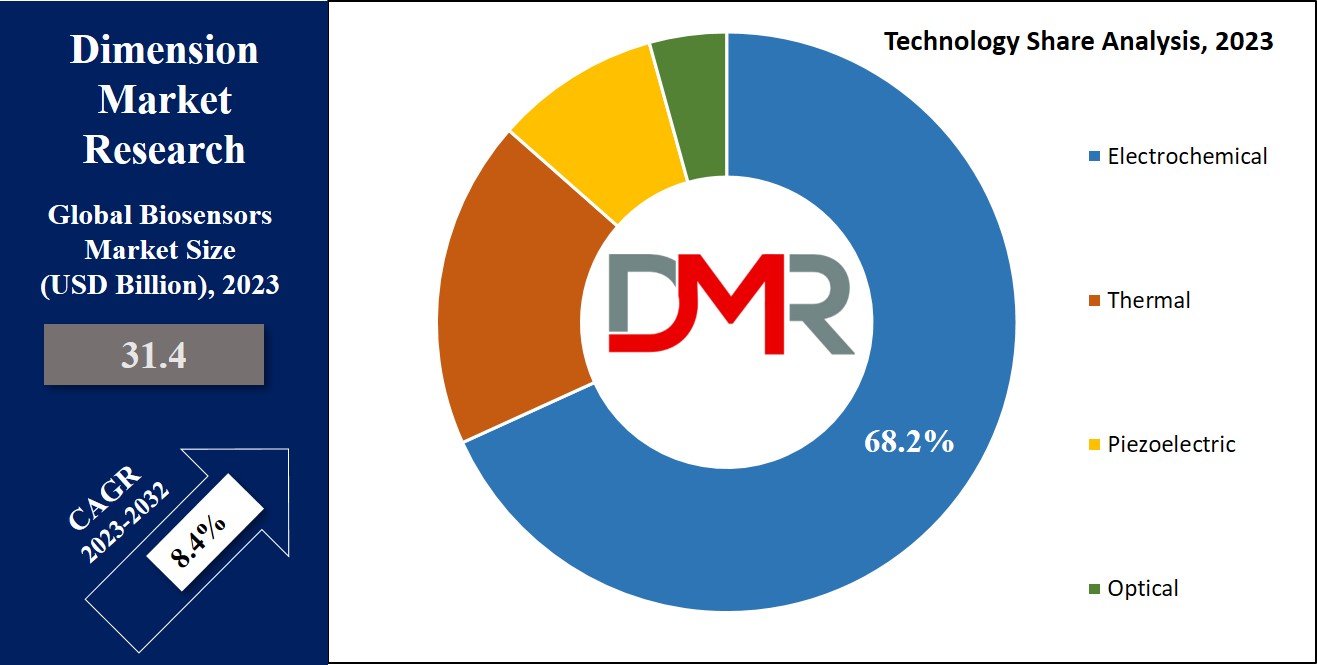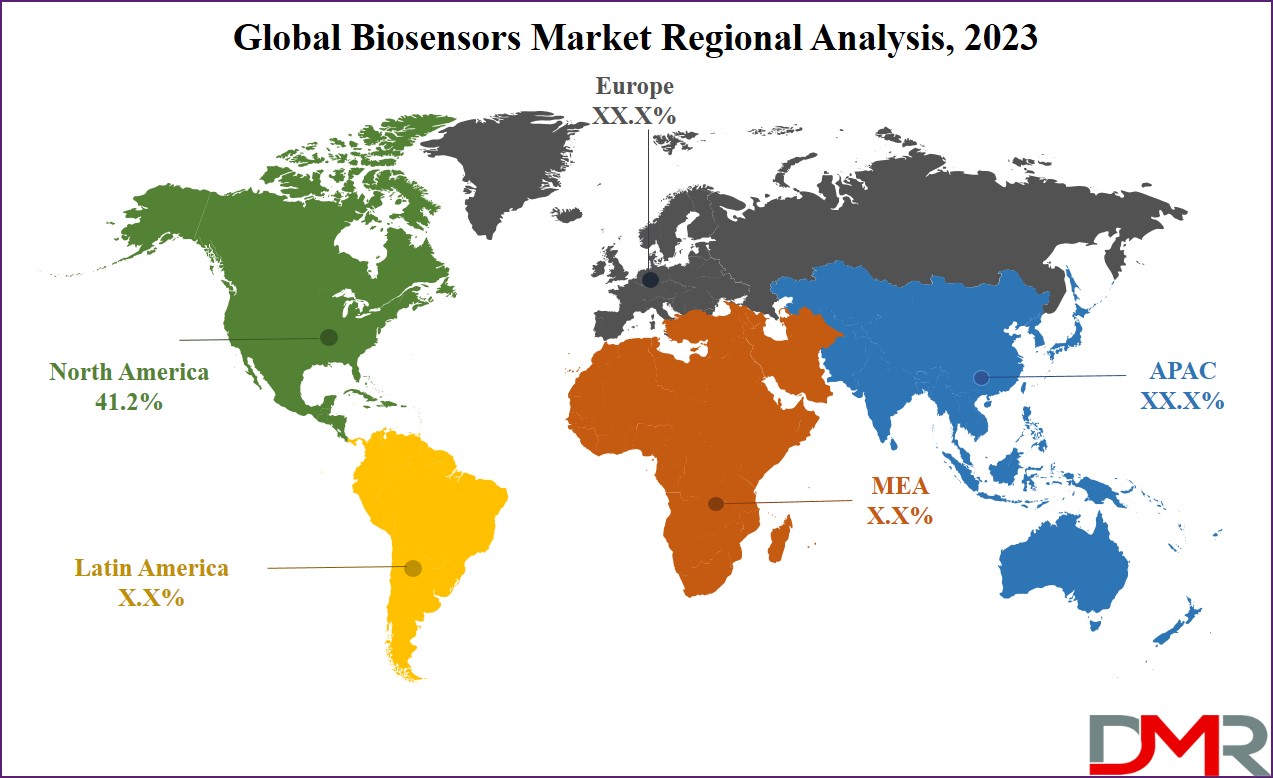Market Overview
The Global Biosensor Market holds a market value of
USD 31.4 billion in 2023 and is further anticipated to reach a market value of
USD 65.0 billion at a CAGR of 8.4% in the upcoming period of 2023 to 2032.
The global biosensor market deals with the production & distribution of biosensors which are a type of analytical equipment that is used in the detection & analysis of different biological or
chemical compounds. These compounds that are used in analysis by biosensors are combined with various biological components such as enzymes, and antibodies and a physicochemical detector like electrochemical, optical, & piezoelectric.
Biosensors are created to provide real-time data about glucose levels, specific biomarkers, pathogens & environmental pollutants based on different parameters. Biosensors are used in various applications, like
medical diagnostics, environmental monitoring &
food quality testing which further boosts the growth of this market. This market is growing at a stable pace as the demand for precise and fast medical diagnostics is growing.
Market Dynamic
The global biosensors market shows many dynamic trends and factors that drive the growth of this market. The rise in the need for rapid & accurate diagnostics of medical conditions which requires continuous monitoring of patients is another factor that pushes the growth of this market. The ongoing technological advancements to enhance the function of biosensors also play a vital role in the growth of this market. Several advancements in this market like sensor sensitivity, specificity, and miniaturization of devices lead to the development of more practical & capable biosensors which push the growth of this market.
This market is growing fast with the growth of the global healthcare sector as currently, patients have started to explore more convenient & timely diagnostics, which further boosts the use of biosensors and pushes the growth of this market.
Also, the growth of this market is affected by different factors like scientific advancements, progress in healthcare facilities, and strict regulatory policies around the world, as this market is highly competitive it will continuously evolve & grow further as biosensors become an essential part of the hospital and healthcare industry.
Research Scope and Analysis
By Technology
Electrochemical technology dominates the biosensors market on the basis of technology, as it also holds 68.2% of the market share in 2023 and is projected to show subsequent growth in the upcoming years of 2023 to 2032 due to their adaptability, sensitivity, & widespread applicability.
Electrochemical biosensors are very popular because they are highly sensitive when facing changes in analyte concentrations of biological & chemical solutions. Another factor regarding the growth of electrochemical technology in the biosensors market is that it provides precise and real-time results, which is critical in emergencies.

It is also used in glucose monitoring for diabetes management, where immediate intervention may be necessary. The electrochemical biosensor size can be reduced, which makes it ideal for the production of point-to-care by using electrochemical technology it can also detect various analytes, including ions, gases, & biomolecules. These factors collectively push forward the growth prospects of the global biosensor market.
By Application
The medical sector dominates the global biosensor market in the context of application as it holds 67% of the market share in 2023. The dominance of the medical sector in this segment can be attributed to their vital role in clinical diagnostics, as they are used in a wide range of medical facilities such as glucose monitoring.
It is also used in the detection of cardiac biomarkers detection, infectious diseases and cancer markers. The ability of biosensors to provide accurate and fast results is a limited time in hospitals further pushing the growth of this sector in the global biosensor market. The rise in the number of chronic patients & the ageing population, also plays a vital role in the growth of the biosensors market as these devices are used for diagnostics.
By End-User
Point-of-Care testing dominates this market in terms of end-users as it holds 49.2% of the market share in 2023. Its dominance can be attributed to the growing demand for real-time diagnostics in the healthcare industry. Point-of-care testing is used in emergencies where timely medical decisions and treatment are required which pushes the growth of this market.
PoC is also popular as it saves time & resources and reduces the need to send samples to specialized laboratories for testing as they give instant results. Also, the easy availability of PoC trying out acts because the most important motive force for the increase of this market, as it is able to be personalized consistent with the patient's particular necessities.
Point-of-care biosensors have facilitated healthcare companies to conduct clinical diagnostics on the affected person's convenience, in clinics, or far off locations, which reduces the load on centralized laboratories and improves patients' scientific condition. In other words, the growth of PoC tests in this market is driven by the continuous advancements in accuracy, sensitivity, and the ability to diagnose various medical conditions. These factors collectively push forward the growth of Point-of-care testing in the global biosensors market.
The Biosensor Market Report is segmented on the basis of the following:
By Technology
- Electrochemical
- Thermal
- Piezoelectric
- Optical
By Application
- Medical
- Food Toxicity
- Bioreactor
- Agriculture
- Environment
- Others
By End-User
- PoC Testing
- Home Healthcare Diagnostics
- Food Industry
- Research Laboratories
- Security and Bio-Defense
Regional Analysis
North America secures the biggest sales proportion inside the worldwide biosensor market as it holds 41.2% in 2023, and is projected to reveal the fastest CAGR in the forthcoming years of 2023 to 2032. The dominance of this place is attributed to the well-developed healthcare quarter in this place. Moreover, the rising focus about the improved operational efficiency of biosensors and their utility in clinical diagnostics is predicted to similarly push the growth of biosensors in this region.

North America has a properly-developed healthcare infrastructure with a wide community of hospitals, clinics, and diagnostics facilities that significantly use biosensors for tests & monitor patients' conditions.
Additionally, this region fosters various regulatory agencies, such as Health Canada and the FDA (Food and Drug Administration) in the United States, that have established clear guidelines for manufacturers for the approval and commercialization of biosensors.
The transparency and well-defined regulatory processes of these government agencies attract investors to invest in biosensor manufacturers in this region and facilitate the growth of the global biosensors market.
By Region
North America
Europe
- Germany
- The U.K.
- France
- Italy
- Russia
- Spain
- Benelux
- Nordic
- Rest of Europe
Asia-Pacific
- China
- Japan
- South Korea
- India
- ANZ
- ASEAN
- Rest of Asia-Pacific
Latin America
- Brazil
- Mexico
- Argentina
- Colombia
- Rest of Latin America
Middle East & Africa
- Saudi Arabia
- UAE
- South Africa
- Israel
- Egypt
- Rest of MEA
Competitive Landscape
The competitive landscape of the global biosensor market is highly dynamic as the market exhibits high fragmentation, offered by global industry & leading regional players These companies invest in R&D through joint ventures to improve their product listings to gain a competitive advantage over others.
Leading companies in this market are constantly engaged in R&D to improve the performance, sensitivity, and selectivity of biosensors Furthermore, leading healthcare industry and research organizations jointly develop biosensors when consumed the key role in the development of biosensors in this market.
These companies focus on improving their products to be more competitive in the market than other established companies. Key players who shape the global biosensors market include Bio-Rad Laboratories Inc., Medtronic, Abbott Laboratories, Biosensors International Group Ltd., Pinnacle Technologies Inc., and other key players.
Some of the prominent players in the Global Biosensors Market are:
- Bio-Rad Laboratories Inc.
- Medtronic
- Abbott Laboratories
- Biosensors International Group Ltd.
- Pinnacle Technologies Inc.
- Ercon Inc.
- DuPont Biosensor Materials
- Johnson & Johnson
- Koninklijke Philips N.V.
- LifeScan Inc.
- QTL Biodetection LLC
- Molecular Devices Corp.
- Other Key Players
COVID-19 Pandemic & Recession: Impact on the Global Biosensors Market:
The COVID-19 pandemic and the following economic recession extensively impacted the worldwide biosensors market. In the initial section of the pandemic, this marketplace saw a shift in investments, as fundamental biosensor manufacturers are actually closely investing in the research & development of products that will provide fast clinical diagnostics, to reduce the exposure risk of COVID-19 virus to healthcare professionals.
The pandemic had a mixed impact on this market as in some cases it even enhanced the growth of this market e.g., the medical device industry used biosensors to detect the first symptoms of patients infected with COVID-19 Biosensors affect nature of materials and physicochemical detectors together - Despite disruptions, the biosensor market is expected to witness steady growth over the long term, mainly due to technological advancements, widespread use of biosensors in healthcare, materials for environmental monitoring, food safety, and biotechnology industries.
Report Details
| Report Characteristics |
| Market Size (2023) |
USD 31.4 Bn |
| Forecast Value (2032) |
USD 65.0 Bn |
| CAGR (2023-2032) |
8.4% |
| Historical Data |
2017 - 2022 |
| Forecast Data |
2023 - 2032 |
| Base Year |
2022 |
| Estimate Year |
2023 |
| Report Coverage |
Market Revenue Estimation, Market Dynamics, Competitive Landscape, Growth Factors and etc. |
| Segments Covered |
By Technology (Electrochemical, Thermal,
Piezoelectric and Optical), By Application (Medical,
Food Toxicity, Bioreactor, Agriculture, Environment
and Others), By End-User (PoC Testing, Home
Healthcare Diagnostics, Food Industry, Research
Laboratories, Security and Bio-Defense) |
| Regional Coverage |
North America – The US and Canada; Europe – Germany, The UK, France, Russia, Spain, Italy, Benelux, Nordic, & Rest of Europe; Asia- Pacific– China, Japan, South Korea, India, ANZ, ASEAN, Rest of APAC; Latin America – Brazil, Mexico, Argentina, Colombia, Rest of Latin America; Middle East & Africa – Saudi Arabia, UAE, South Africa, Turkey, Egypt, Israel, & Rest of MEA
|
| Prominent Players |
Bio-Rad Laboratories Inc., Medtronic, Abbott
Laboratories, Biosensors International Group Ltd.,
Pinnacle Technologies Inc., Ercon Inc., DuPont
Biosensor Materials, Johnson & Johnson, Koninklijke
Philips N.V., LifeScan Inc., QTL Biodetection LLC,
Molecular Devices Corp, and Other Key Players |
| Purchase Options |
We have three licenses to opt for: Single User License (Limited to 1 user), Multi-User License (Up to 5 Users), and Corporate Use License (Unlimited User) along with free report customization equivalent to 0 analyst working days, 3 analysts working days and 5 analysts working days respectively. |
Frequently Asked Questions
The Global Biosensors Market is expected to reach a value of USD 31.4 billion in 2023.
The Global Biosensors Market is expected to grow at a compound annual growth rate of 8.4% from 2023
to 2032.
North America dominates the Global Biosensors Market accounting for 41.2% in 2023.
Some of the prominent players in the Global Biosensors Market include Bio-Rad Laboratories Inc.,
Medtronic, Abbott Laboratories, Biosensors International Group Ltd., Pinnacle Technologies Inc., Ercon
Inc., DuPont Biosensor Materials, Johnson & Johnson, Koninklijke Philips N.V., LifeScan Inc., QTL
Biodetection LLC, Molecular Devices Corp. and others.